BSBRSK501 Manage Risk: Observation Checklist for Competency in Risk
VerifiedAdded on 2023/06/10
|103
|12099
|172
Practical Assignment
AI Summary
This document provides a comprehensive observation checklist for the BSBRSK501 Manage Risk unit, designed to assess a learner's competency in establishing risk context, identifying risks, analyzing risks, and selecting and implementing treatments. It includes elements for competency demonstration, foundation skills required (reading, writing, oral communication, numeracy, navigating the world of work, interacting with others, and getting the work done), knowledge evidence, and assessment conditions. The checklist outlines specific tasks to be observed or demonstrated, such as reviewing organizational processes, determining scope for risk management, identifying stakeholders, and assessing the likelihood and impact of risks. The document also includes definitions of assessment tools, such as learner workbooks, major activities, skills and knowledge activities, third-party checklists, and case studies, and provides guidance for assessors on conducting observations and demonstrations, ensuring all documentation is in order, and evaluating the risk management process. The final assessment result is either satisfactory or not satisfactory.
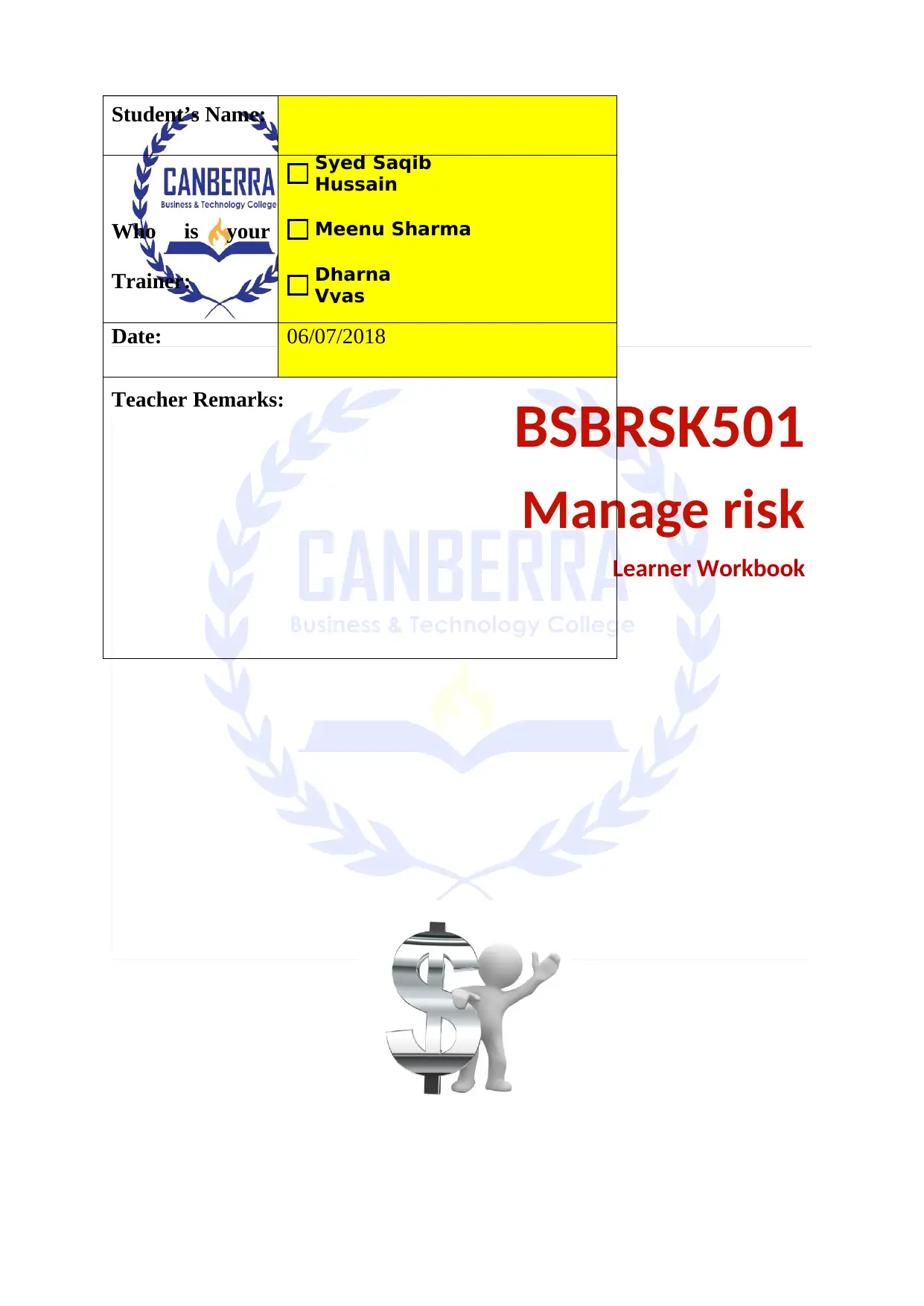
BSBRSK501
Manage risk
Learner Workbook
Student’s Name:
Who is your
Trainer:
Date: 06/07/2018
Teacher Remarks:
Syed Saqib
Hussain
Meenu Sharma
Dharna
Vyas
Manage risk
Learner Workbook
Student’s Name:
Who is your
Trainer:
Date: 06/07/2018
Teacher Remarks:
Syed Saqib
Hussain
Meenu Sharma
Dharna
Vyas
Paraphrase This Document
Need a fresh take? Get an instant paraphrase of this document with our AI Paraphraser
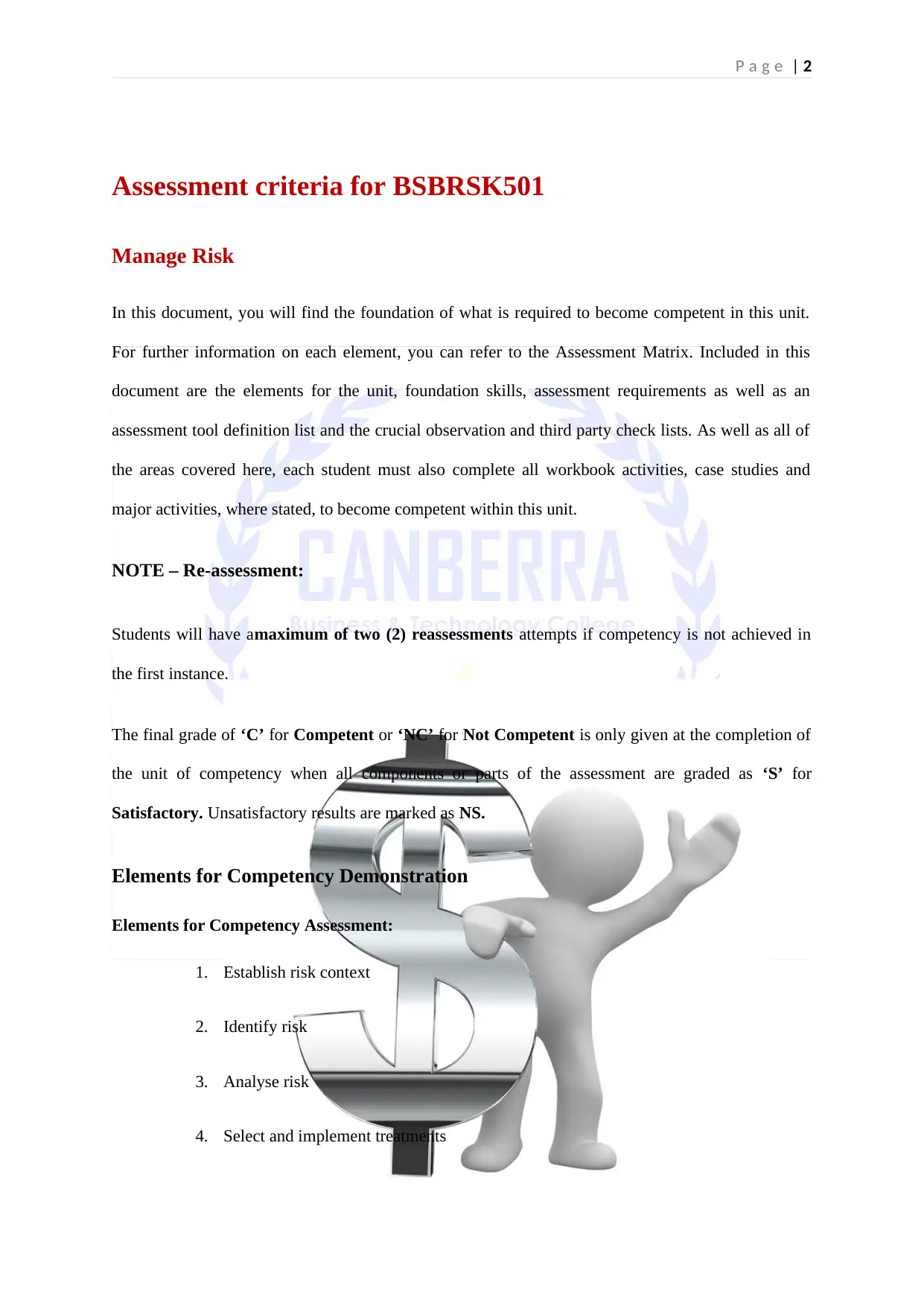
P a g e | 2
Assessment criteria for BSBRSK501
Manage Risk
In this document, you will find the foundation of what is required to become competent in this unit.
For further information on each element, you can refer to the Assessment Matrix. Included in this
document are the elements for the unit, foundation skills, assessment requirements as well as an
assessment tool definition list and the crucial observation and third party check lists. As well as all of
the areas covered here, each student must also complete all workbook activities, case studies and
major activities, where stated, to become competent within this unit.
NOTE – Re-assessment:
Students will have amaximum of two (2) reassessments attempts if competency is not achieved in
the first instance.
The final grade of ‘C’ for Competent or ‘NC’ for Not Competent is only given at the completion of
the unit of competency when all components or parts of the assessment are graded as ‘S’ for
Satisfactory. Unsatisfactory results are marked as NS.
Elements for Competency Demonstration
Elements for Competency Assessment:
1. Establish risk context
2. Identify risk
3. Analyse risk
4. Select and implement treatments
Assessment criteria for BSBRSK501
Manage Risk
In this document, you will find the foundation of what is required to become competent in this unit.
For further information on each element, you can refer to the Assessment Matrix. Included in this
document are the elements for the unit, foundation skills, assessment requirements as well as an
assessment tool definition list and the crucial observation and third party check lists. As well as all of
the areas covered here, each student must also complete all workbook activities, case studies and
major activities, where stated, to become competent within this unit.
NOTE – Re-assessment:
Students will have amaximum of two (2) reassessments attempts if competency is not achieved in
the first instance.
The final grade of ‘C’ for Competent or ‘NC’ for Not Competent is only given at the completion of
the unit of competency when all components or parts of the assessment are graded as ‘S’ for
Satisfactory. Unsatisfactory results are marked as NS.
Elements for Competency Demonstration
Elements for Competency Assessment:
1. Establish risk context
2. Identify risk
3. Analyse risk
4. Select and implement treatments
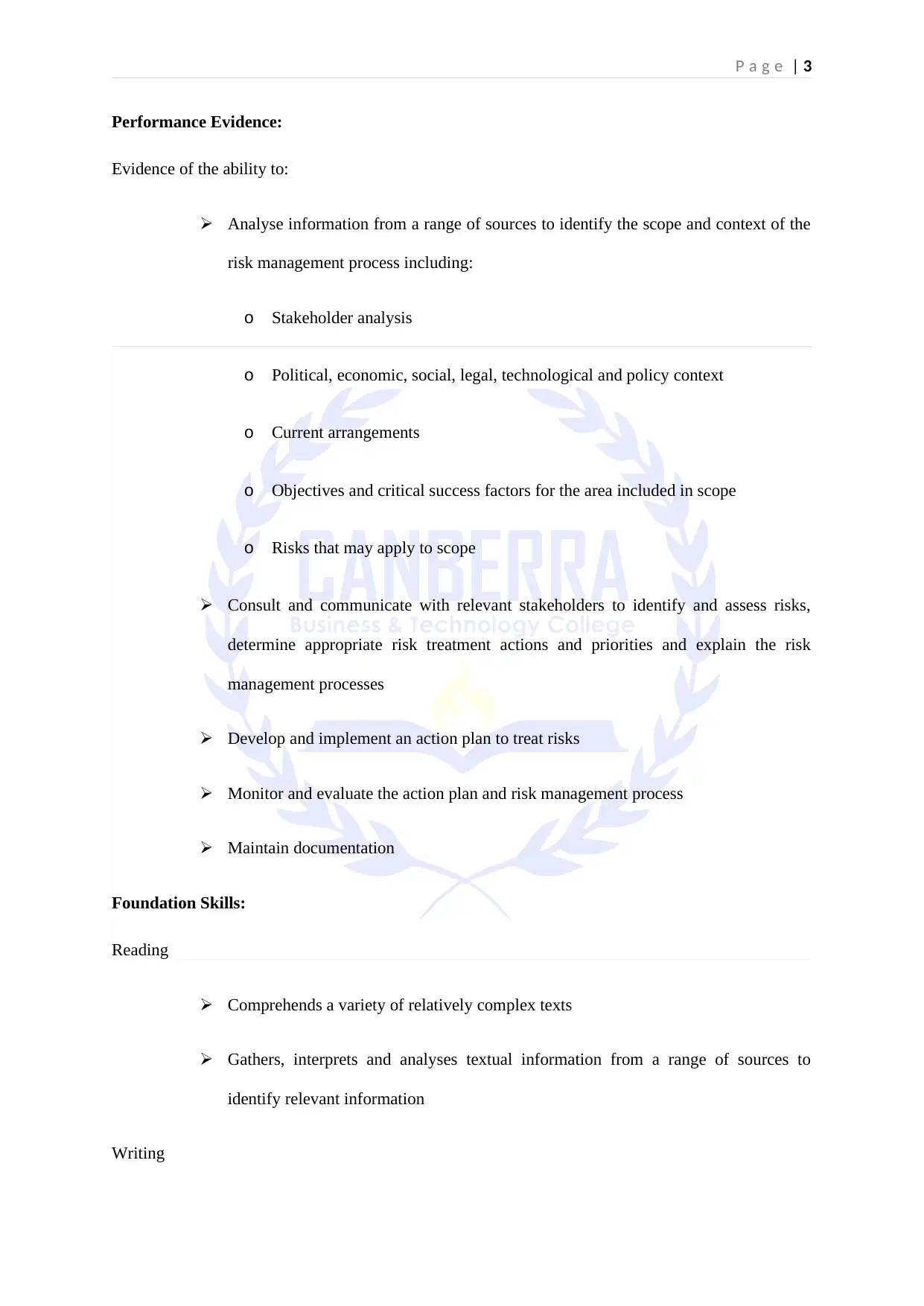
P a g e | 3
Performance Evidence:
Evidence of the ability to:
Analyse information from a range of sources to identify the scope and context of the
risk management process including:
o Stakeholder analysis
o Political, economic, social, legal, technological and policy context
o Current arrangements
o Objectives and critical success factors for the area included in scope
o Risks that may apply to scope
Consult and communicate with relevant stakeholders to identify and assess risks,
determine appropriate risk treatment actions and priorities and explain the risk
management processes
Develop and implement an action plan to treat risks
Monitor and evaluate the action plan and risk management process
Maintain documentation
Foundation Skills:
Reading
Comprehends a variety of relatively complex texts
Gathers, interprets and analyses textual information from a range of sources to
identify relevant information
Writing
Performance Evidence:
Evidence of the ability to:
Analyse information from a range of sources to identify the scope and context of the
risk management process including:
o Stakeholder analysis
o Political, economic, social, legal, technological and policy context
o Current arrangements
o Objectives and critical success factors for the area included in scope
o Risks that may apply to scope
Consult and communicate with relevant stakeholders to identify and assess risks,
determine appropriate risk treatment actions and priorities and explain the risk
management processes
Develop and implement an action plan to treat risks
Monitor and evaluate the action plan and risk management process
Maintain documentation
Foundation Skills:
Reading
Comprehends a variety of relatively complex texts
Gathers, interprets and analyses textual information from a range of sources to
identify relevant information
Writing
⊘ This is a preview!⊘
Do you want full access?
Subscribe today to unlock all pages.

Trusted by 1+ million students worldwide
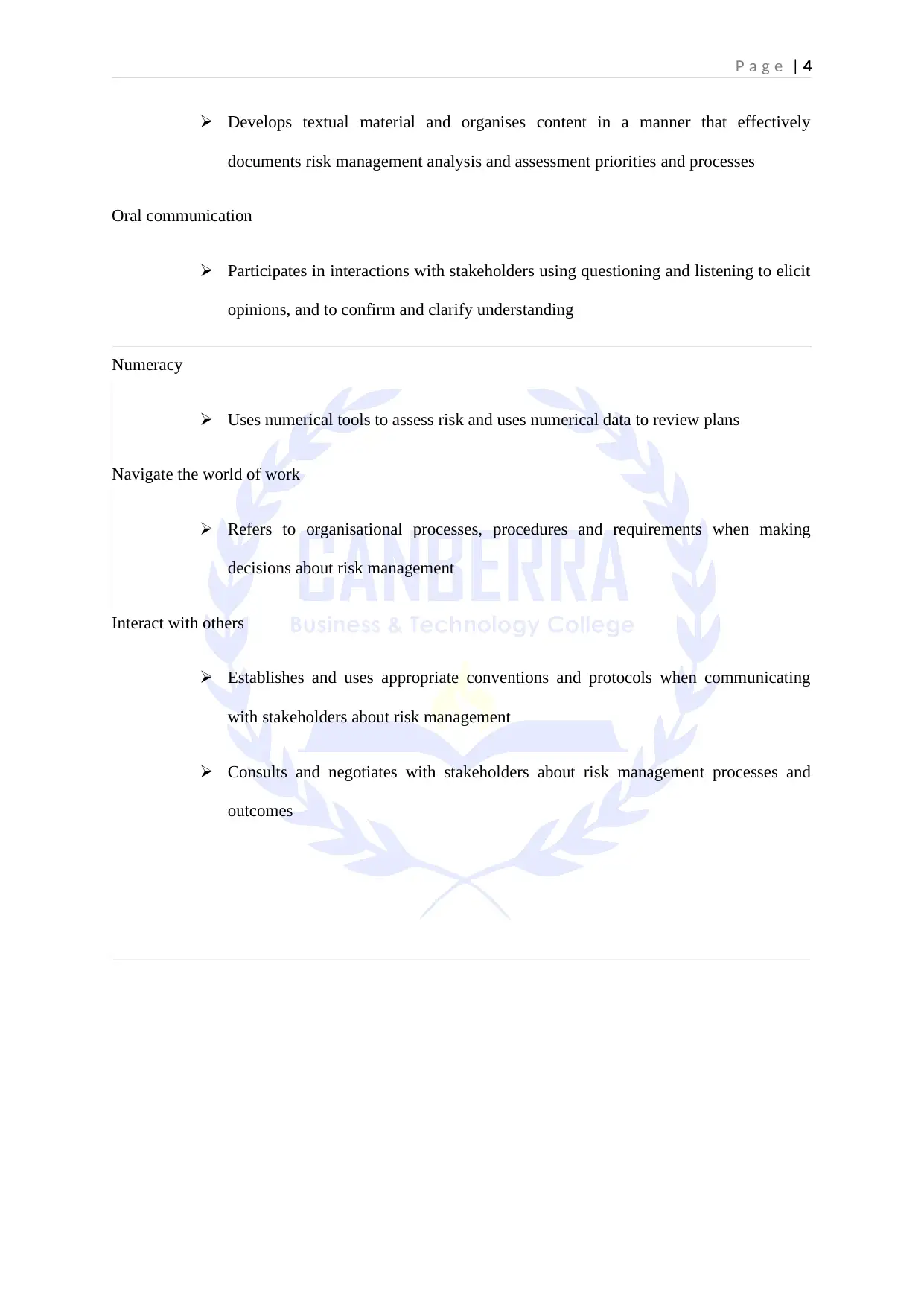
P a g e | 4
Develops textual material and organises content in a manner that effectively
documents risk management analysis and assessment priorities and processes
Oral communication
Participates in interactions with stakeholders using questioning and listening to elicit
opinions, and to confirm and clarify understanding
Numeracy
Uses numerical tools to assess risk and uses numerical data to review plans
Navigate the world of work
Refers to organisational processes, procedures and requirements when making
decisions about risk management
Interact with others
Establishes and uses appropriate conventions and protocols when communicating
with stakeholders about risk management
Consults and negotiates with stakeholders about risk management processes and
outcomes
Develops textual material and organises content in a manner that effectively
documents risk management analysis and assessment priorities and processes
Oral communication
Participates in interactions with stakeholders using questioning and listening to elicit
opinions, and to confirm and clarify understanding
Numeracy
Uses numerical tools to assess risk and uses numerical data to review plans
Navigate the world of work
Refers to organisational processes, procedures and requirements when making
decisions about risk management
Interact with others
Establishes and uses appropriate conventions and protocols when communicating
with stakeholders about risk management
Consults and negotiates with stakeholders about risk management processes and
outcomes
Paraphrase This Document
Need a fresh take? Get an instant paraphrase of this document with our AI Paraphraser
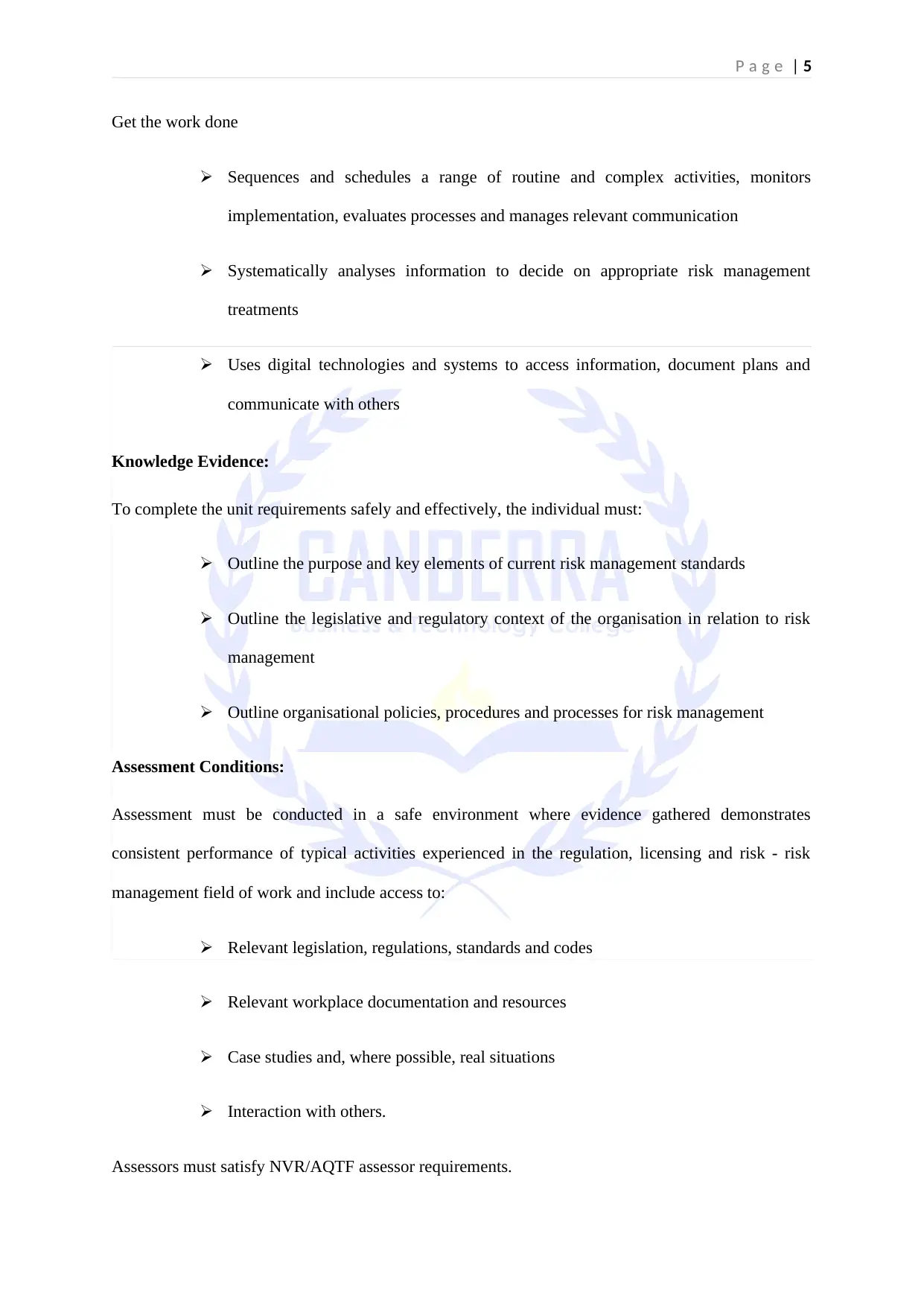
P a g e | 5
Get the work done
Sequences and schedules a range of routine and complex activities, monitors
implementation, evaluates processes and manages relevant communication
Systematically analyses information to decide on appropriate risk management
treatments
Uses digital technologies and systems to access information, document plans and
communicate with others
Knowledge Evidence:
To complete the unit requirements safely and effectively, the individual must:
Outline the purpose and key elements of current risk management standards
Outline the legislative and regulatory context of the organisation in relation to risk
management
Outline organisational policies, procedures and processes for risk management
Assessment Conditions:
Assessment must be conducted in a safe environment where evidence gathered demonstrates
consistent performance of typical activities experienced in the regulation, licensing and risk - risk
management field of work and include access to:
Relevant legislation, regulations, standards and codes
Relevant workplace documentation and resources
Case studies and, where possible, real situations
Interaction with others.
Assessors must satisfy NVR/AQTF assessor requirements.
Get the work done
Sequences and schedules a range of routine and complex activities, monitors
implementation, evaluates processes and manages relevant communication
Systematically analyses information to decide on appropriate risk management
treatments
Uses digital technologies and systems to access information, document plans and
communicate with others
Knowledge Evidence:
To complete the unit requirements safely and effectively, the individual must:
Outline the purpose and key elements of current risk management standards
Outline the legislative and regulatory context of the organisation in relation to risk
management
Outline organisational policies, procedures and processes for risk management
Assessment Conditions:
Assessment must be conducted in a safe environment where evidence gathered demonstrates
consistent performance of typical activities experienced in the regulation, licensing and risk - risk
management field of work and include access to:
Relevant legislation, regulations, standards and codes
Relevant workplace documentation and resources
Case studies and, where possible, real situations
Interaction with others.
Assessors must satisfy NVR/AQTF assessor requirements.
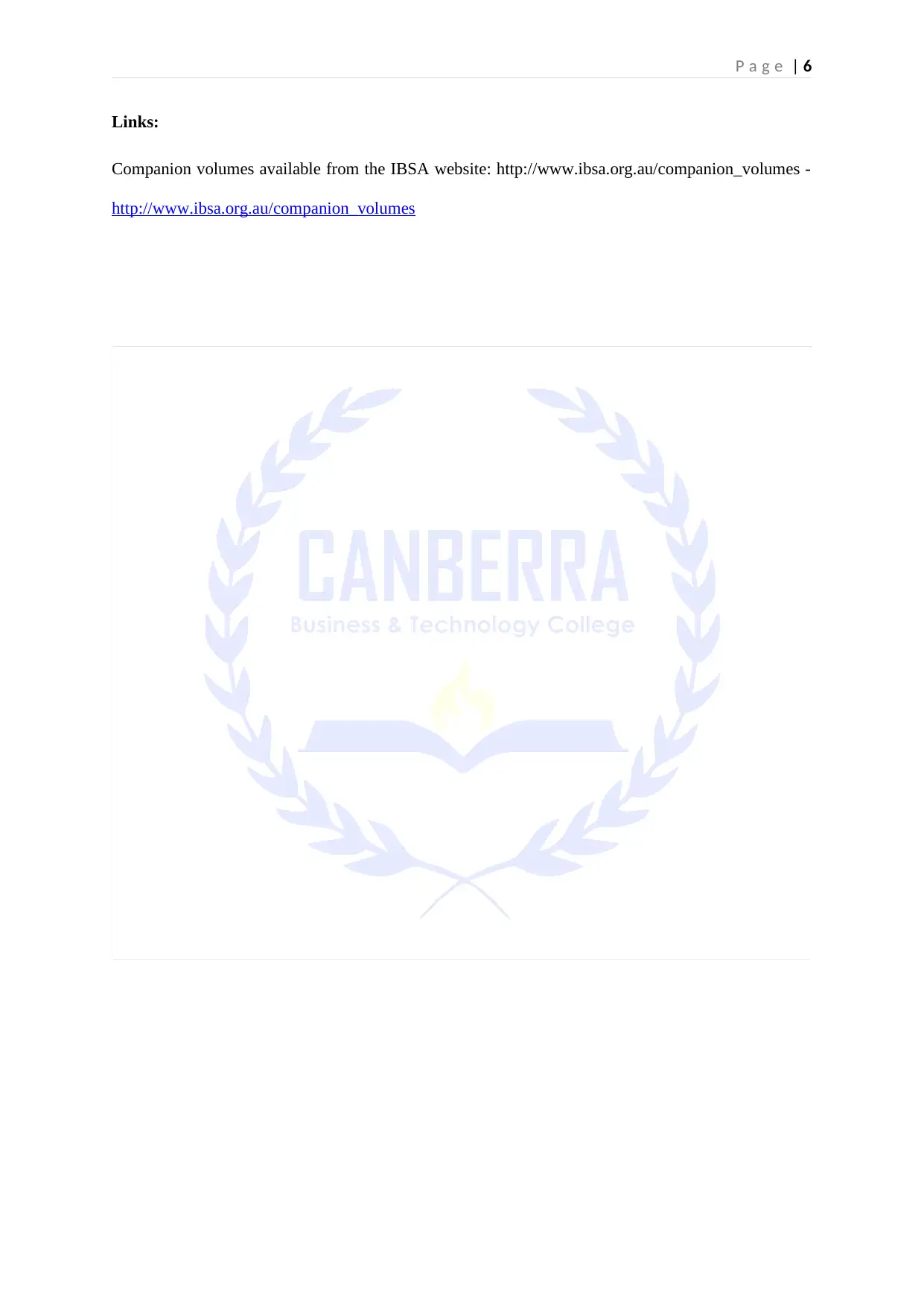
P a g e | 6
Links:
Companion volumes available from the IBSA website: http://www.ibsa.org.au/companion_volumes -
http://www.ibsa.org.au/companion_volumes
Links:
Companion volumes available from the IBSA website: http://www.ibsa.org.au/companion_volumes -
http://www.ibsa.org.au/companion_volumes
⊘ This is a preview!⊘
Do you want full access?
Subscribe today to unlock all pages.

Trusted by 1+ million students worldwide
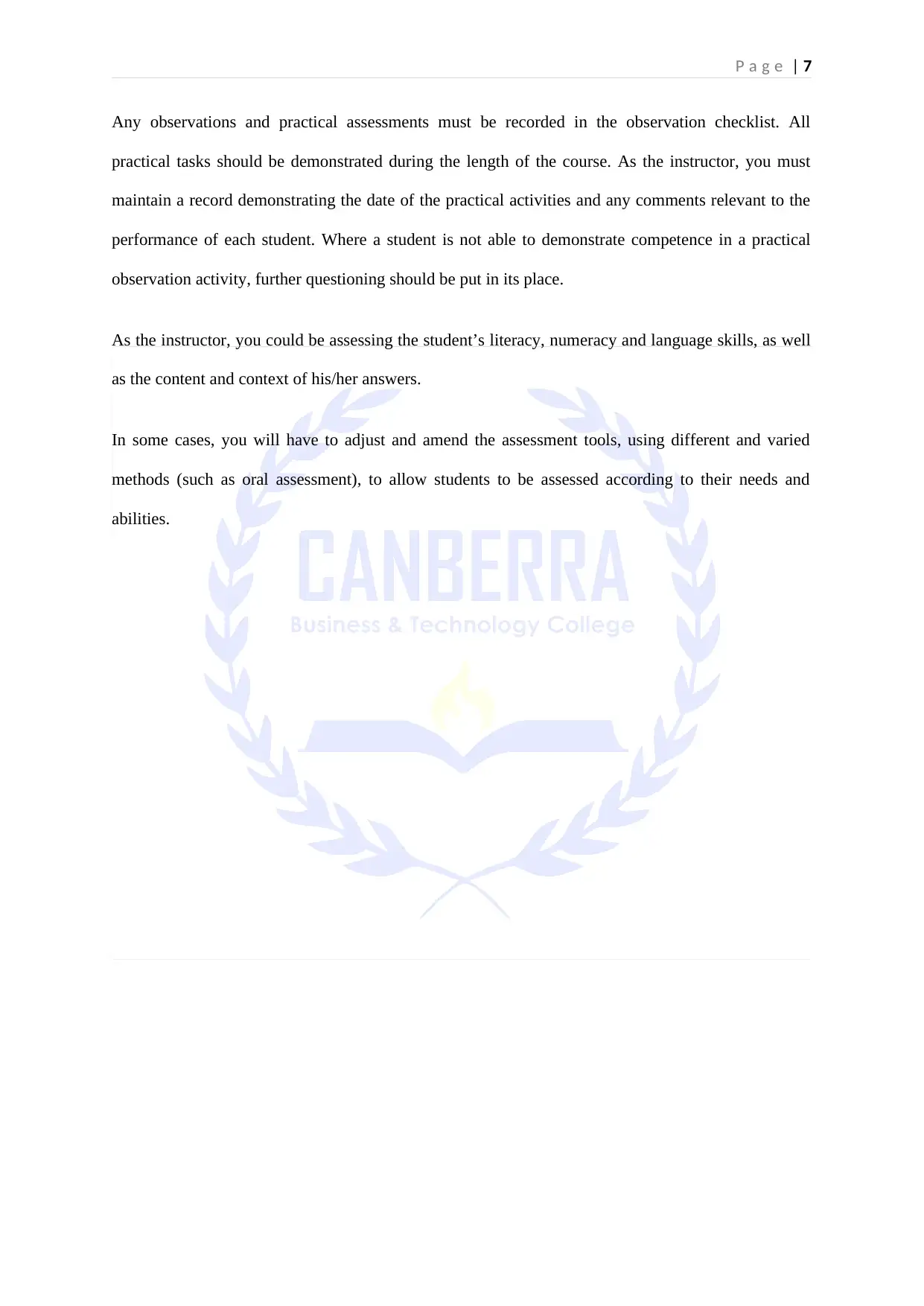
P a g e | 7
Any observations and practical assessments must be recorded in the observation checklist. All
practical tasks should be demonstrated during the length of the course. As the instructor, you must
maintain a record demonstrating the date of the practical activities and any comments relevant to the
performance of each student. Where a student is not able to demonstrate competence in a practical
observation activity, further questioning should be put in its place.
As the instructor, you could be assessing the student’s literacy, numeracy and language skills, as well
as the content and context of his/her answers.
In some cases, you will have to adjust and amend the assessment tools, using different and varied
methods (such as oral assessment), to allow students to be assessed according to their needs and
abilities.
Any observations and practical assessments must be recorded in the observation checklist. All
practical tasks should be demonstrated during the length of the course. As the instructor, you must
maintain a record demonstrating the date of the practical activities and any comments relevant to the
performance of each student. Where a student is not able to demonstrate competence in a practical
observation activity, further questioning should be put in its place.
As the instructor, you could be assessing the student’s literacy, numeracy and language skills, as well
as the content and context of his/her answers.
In some cases, you will have to adjust and amend the assessment tools, using different and varied
methods (such as oral assessment), to allow students to be assessed according to their needs and
abilities.
Paraphrase This Document
Need a fresh take? Get an instant paraphrase of this document with our AI Paraphraser
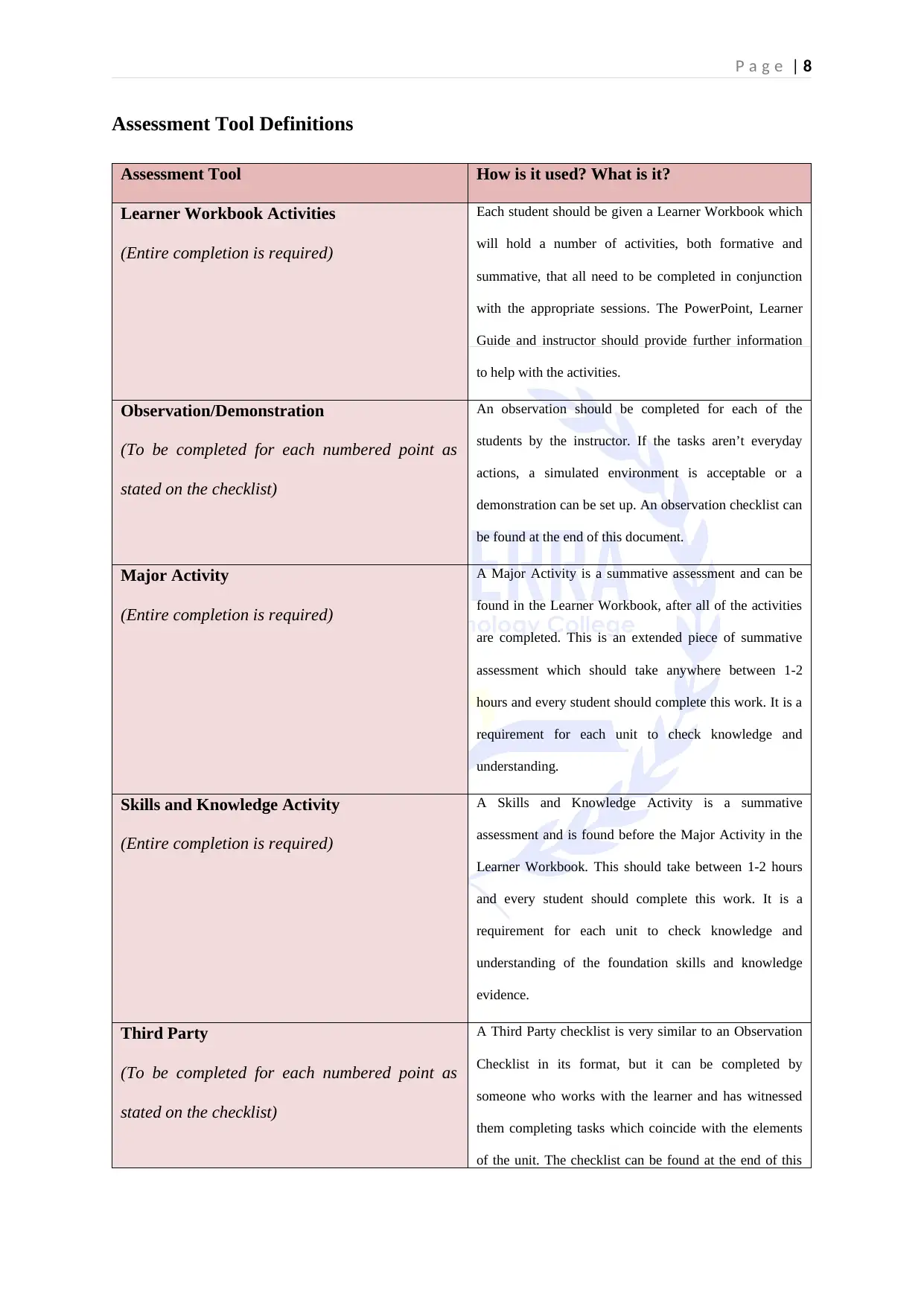
P a g e | 8
Assessment Tool Definitions
Assessment Tool How is it used? What is it?
Learner Workbook Activities
(Entire completion is required)
Each student should be given a Learner Workbook which
will hold a number of activities, both formative and
summative, that all need to be completed in conjunction
with the appropriate sessions. The PowerPoint, Learner
Guide and instructor should provide further information
to help with the activities.
Observation/Demonstration
(To be completed for each numbered point as
stated on the checklist)
An observation should be completed for each of the
students by the instructor. If the tasks aren’t everyday
actions, a simulated environment is acceptable or a
demonstration can be set up. An observation checklist can
be found at the end of this document.
Major Activity
(Entire completion is required)
A Major Activity is a summative assessment and can be
found in the Learner Workbook, after all of the activities
are completed. This is an extended piece of summative
assessment which should take anywhere between 1-2
hours and every student should complete this work. It is a
requirement for each unit to check knowledge and
understanding.
Skills and Knowledge Activity
(Entire completion is required)
A Skills and Knowledge Activity is a summative
assessment and is found before the Major Activity in the
Learner Workbook. This should take between 1-2 hours
and every student should complete this work. It is a
requirement for each unit to check knowledge and
understanding of the foundation skills and knowledge
evidence.
Third Party
(To be completed for each numbered point as
stated on the checklist)
A Third Party checklist is very similar to an Observation
Checklist in its format, but it can be completed by
someone who works with the learner and has witnessed
them completing tasks which coincide with the elements
of the unit. The checklist can be found at the end of this
Assessment Tool Definitions
Assessment Tool How is it used? What is it?
Learner Workbook Activities
(Entire completion is required)
Each student should be given a Learner Workbook which
will hold a number of activities, both formative and
summative, that all need to be completed in conjunction
with the appropriate sessions. The PowerPoint, Learner
Guide and instructor should provide further information
to help with the activities.
Observation/Demonstration
(To be completed for each numbered point as
stated on the checklist)
An observation should be completed for each of the
students by the instructor. If the tasks aren’t everyday
actions, a simulated environment is acceptable or a
demonstration can be set up. An observation checklist can
be found at the end of this document.
Major Activity
(Entire completion is required)
A Major Activity is a summative assessment and can be
found in the Learner Workbook, after all of the activities
are completed. This is an extended piece of summative
assessment which should take anywhere between 1-2
hours and every student should complete this work. It is a
requirement for each unit to check knowledge and
understanding.
Skills and Knowledge Activity
(Entire completion is required)
A Skills and Knowledge Activity is a summative
assessment and is found before the Major Activity in the
Learner Workbook. This should take between 1-2 hours
and every student should complete this work. It is a
requirement for each unit to check knowledge and
understanding of the foundation skills and knowledge
evidence.
Third Party
(To be completed for each numbered point as
stated on the checklist)
A Third Party checklist is very similar to an Observation
Checklist in its format, but it can be completed by
someone who works with the learner and has witnessed
them completing tasks which coincide with the elements
of the unit. The checklist can be found at the end of this
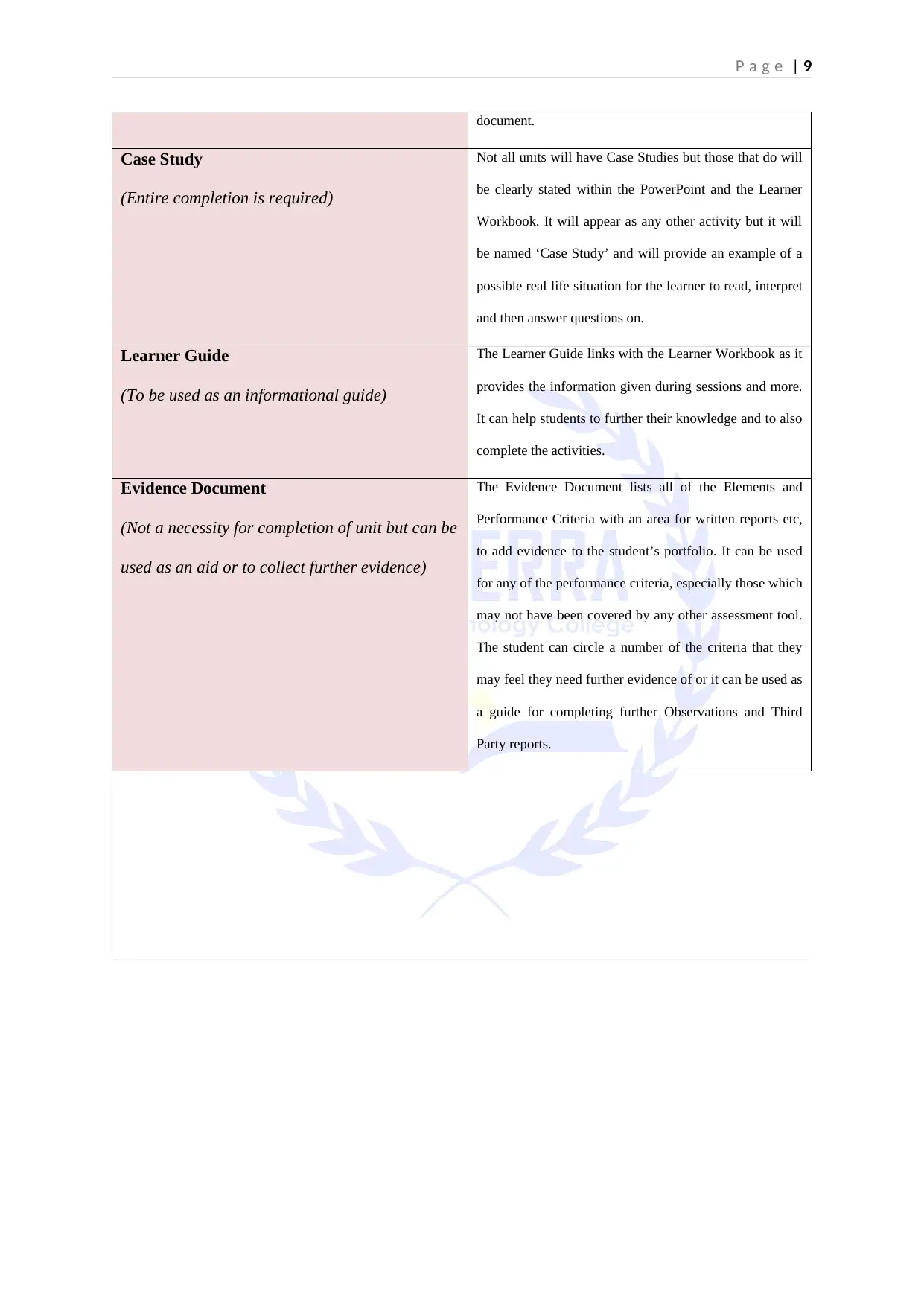
P a g e | 9
document.
Case Study
(Entire completion is required)
Not all units will have Case Studies but those that do will
be clearly stated within the PowerPoint and the Learner
Workbook. It will appear as any other activity but it will
be named ‘Case Study’ and will provide an example of a
possible real life situation for the learner to read, interpret
and then answer questions on.
Learner Guide
(To be used as an informational guide)
The Learner Guide links with the Learner Workbook as it
provides the information given during sessions and more.
It can help students to further their knowledge and to also
complete the activities.
Evidence Document
(Not a necessity for completion of unit but can be
used as an aid or to collect further evidence)
The Evidence Document lists all of the Elements and
Performance Criteria with an area for written reports etc,
to add evidence to the student’s portfolio. It can be used
for any of the performance criteria, especially those which
may not have been covered by any other assessment tool.
The student can circle a number of the criteria that they
may feel they need further evidence of or it can be used as
a guide for completing further Observations and Third
Party reports.
document.
Case Study
(Entire completion is required)
Not all units will have Case Studies but those that do will
be clearly stated within the PowerPoint and the Learner
Workbook. It will appear as any other activity but it will
be named ‘Case Study’ and will provide an example of a
possible real life situation for the learner to read, interpret
and then answer questions on.
Learner Guide
(To be used as an informational guide)
The Learner Guide links with the Learner Workbook as it
provides the information given during sessions and more.
It can help students to further their knowledge and to also
complete the activities.
Evidence Document
(Not a necessity for completion of unit but can be
used as an aid or to collect further evidence)
The Evidence Document lists all of the Elements and
Performance Criteria with an area for written reports etc,
to add evidence to the student’s portfolio. It can be used
for any of the performance criteria, especially those which
may not have been covered by any other assessment tool.
The student can circle a number of the criteria that they
may feel they need further evidence of or it can be used as
a guide for completing further Observations and Third
Party reports.
⊘ This is a preview!⊘
Do you want full access?
Subscribe today to unlock all pages.

Trusted by 1+ million students worldwide
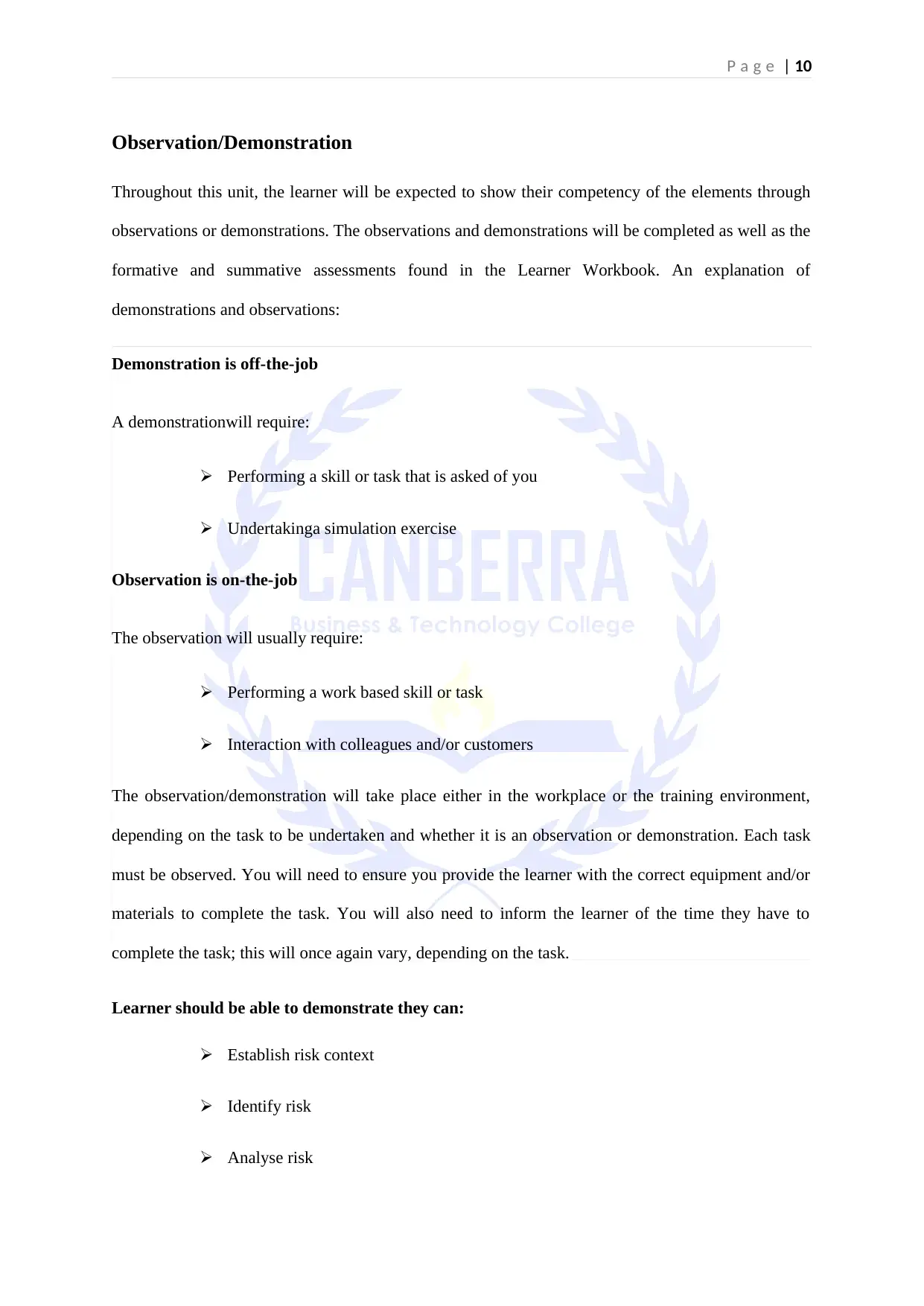
P a g e | 10
Observation/Demonstration
Throughout this unit, the learner will be expected to show their competency of the elements through
observations or demonstrations. The observations and demonstrations will be completed as well as the
formative and summative assessments found in the Learner Workbook. An explanation of
demonstrations and observations:
Demonstration is off-the-job
A demonstrationwill require:
Performing a skill or task that is asked of you
Undertakinga simulation exercise
Observation is on-the-job
The observation will usually require:
Performing a work based skill or task
Interaction with colleagues and/or customers
The observation/demonstration will take place either in the workplace or the training environment,
depending on the task to be undertaken and whether it is an observation or demonstration. Each task
must be observed. You will need to ensure you provide the learner with the correct equipment and/or
materials to complete the task. You will also need to inform the learner of the time they have to
complete the task; this will once again vary, depending on the task.
Learner should be able to demonstrate they can:
Establish risk context
Identify risk
Analyse risk
Observation/Demonstration
Throughout this unit, the learner will be expected to show their competency of the elements through
observations or demonstrations. The observations and demonstrations will be completed as well as the
formative and summative assessments found in the Learner Workbook. An explanation of
demonstrations and observations:
Demonstration is off-the-job
A demonstrationwill require:
Performing a skill or task that is asked of you
Undertakinga simulation exercise
Observation is on-the-job
The observation will usually require:
Performing a work based skill or task
Interaction with colleagues and/or customers
The observation/demonstration will take place either in the workplace or the training environment,
depending on the task to be undertaken and whether it is an observation or demonstration. Each task
must be observed. You will need to ensure you provide the learner with the correct equipment and/or
materials to complete the task. You will also need to inform the learner of the time they have to
complete the task; this will once again vary, depending on the task.
Learner should be able to demonstrate they can:
Establish risk context
Identify risk
Analyse risk
Paraphrase This Document
Need a fresh take? Get an instant paraphrase of this document with our AI Paraphraser
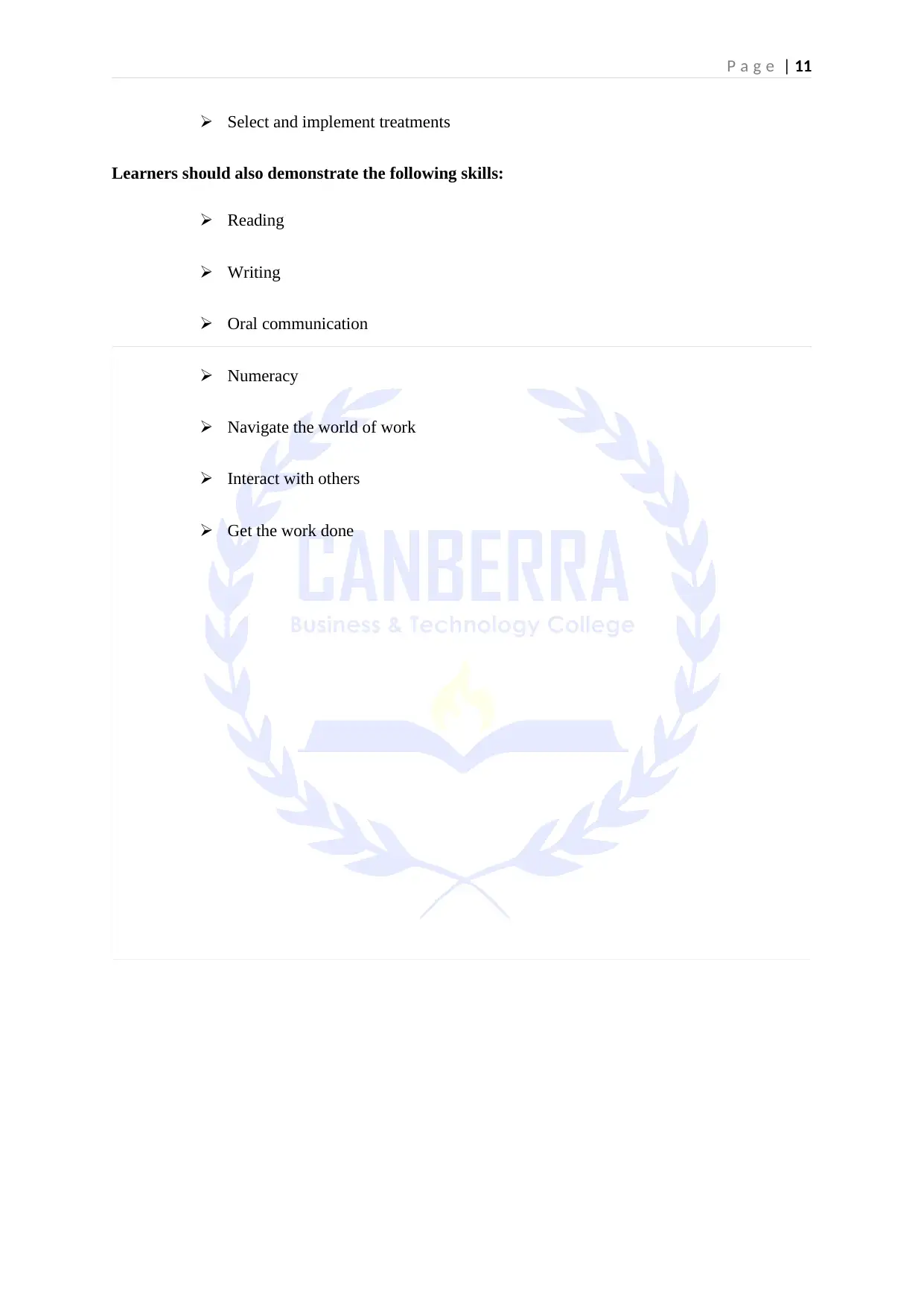
P a g e | 11
Select and implement treatments
Learners should also demonstrate the following skills:
Reading
Writing
Oral communication
Numeracy
Navigate the world of work
Interact with others
Get the work done
Select and implement treatments
Learners should also demonstrate the following skills:
Reading
Writing
Oral communication
Numeracy
Navigate the world of work
Interact with others
Get the work done
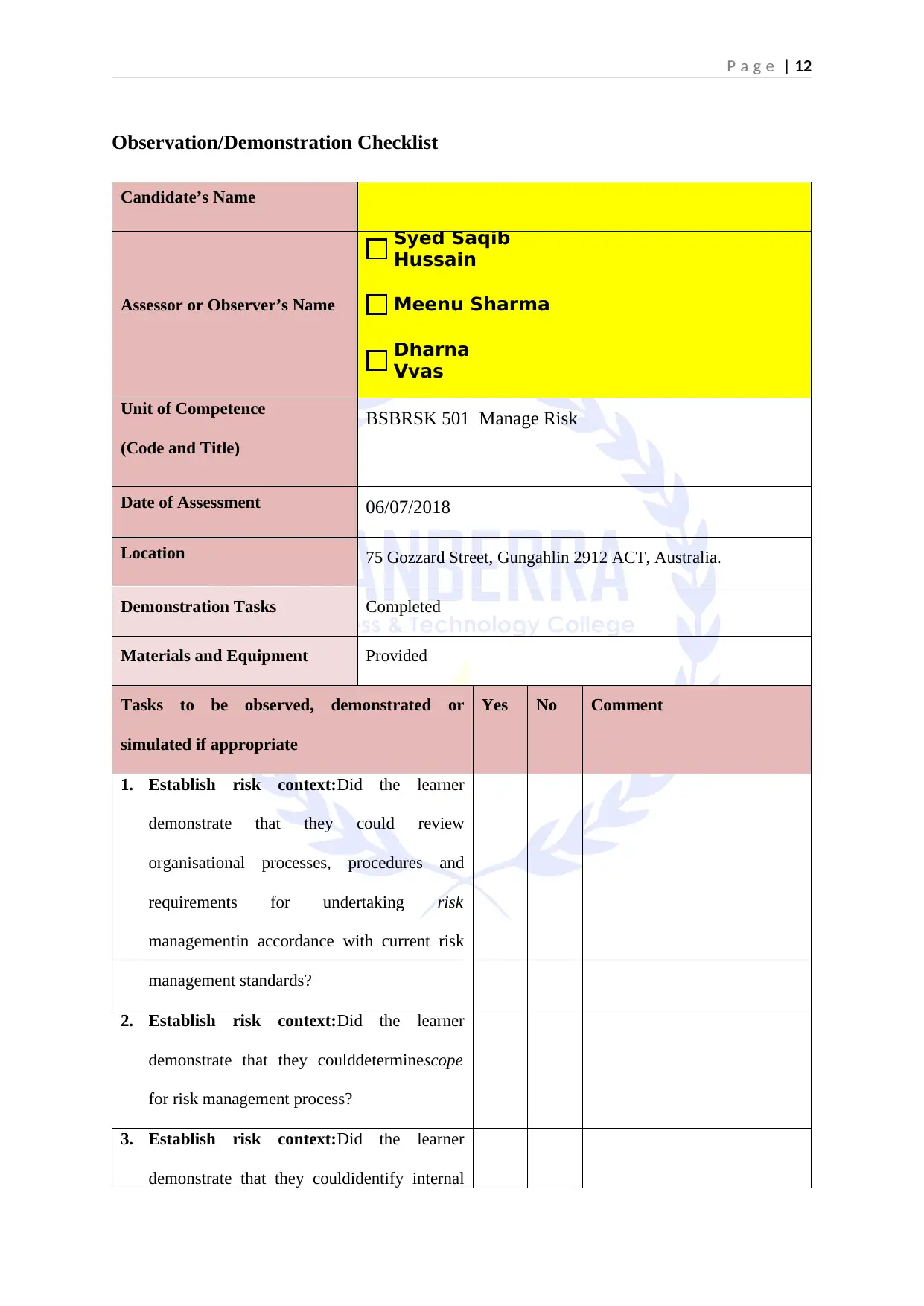
P a g e | 12
Observation/Demonstration Checklist
Candidate’s Name
Assessor or Observer’s Name
Unit of Competence
(Code and Title)
BSBRSK 501 Manage Risk
Date of Assessment 06/07/2018
Location 75 Gozzard Street, Gungahlin 2912 ACT, Australia.
Demonstration Tasks Completed
Materials and Equipment Provided
Tasks to be observed, demonstrated or
simulated if appropriate
Yes No Comment
1. Establish risk context:Did the learner
demonstrate that they could review
organisational processes, procedures and
requirements for undertaking risk
managementin accordance with current risk
management standards?
2. Establish risk context:Did the learner
demonstrate that they coulddeterminescope
for risk management process?
3. Establish risk context:Did the learner
demonstrate that they couldidentify internal
Syed Saqib
Hussain
Meenu Sharma
Dharna
Vyas
Observation/Demonstration Checklist
Candidate’s Name
Assessor or Observer’s Name
Unit of Competence
(Code and Title)
BSBRSK 501 Manage Risk
Date of Assessment 06/07/2018
Location 75 Gozzard Street, Gungahlin 2912 ACT, Australia.
Demonstration Tasks Completed
Materials and Equipment Provided
Tasks to be observed, demonstrated or
simulated if appropriate
Yes No Comment
1. Establish risk context:Did the learner
demonstrate that they could review
organisational processes, procedures and
requirements for undertaking risk
managementin accordance with current risk
management standards?
2. Establish risk context:Did the learner
demonstrate that they coulddeterminescope
for risk management process?
3. Establish risk context:Did the learner
demonstrate that they couldidentify internal
Syed Saqib
Hussain
Meenu Sharma
Dharna
Vyas
⊘ This is a preview!⊘
Do you want full access?
Subscribe today to unlock all pages.

Trusted by 1+ million students worldwide
1 out of 103
Related Documents
Your All-in-One AI-Powered Toolkit for Academic Success.
+13062052269
info@desklib.com
Available 24*7 on WhatsApp / Email
![[object Object]](/_next/static/media/star-bottom.7253800d.svg)
Unlock your academic potential
Copyright © 2020–2025 A2Z Services. All Rights Reserved. Developed and managed by ZUCOL.





